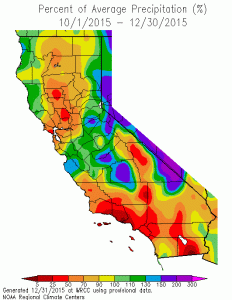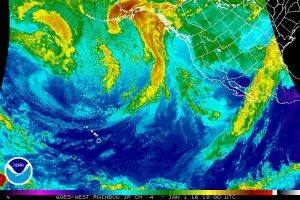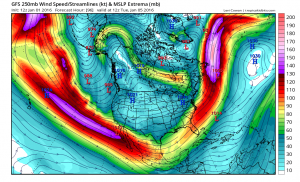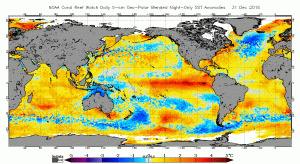Relatively dry conditions persist in Southern California; Sierra Nevada snowfall best in years
Relatively little has changed since my last update, and so the present post will be a short one.

A handful of modest weather systems have brought generally light precipitation and cold temperatures to parts of California over the past week or so, mostly in the north. While these systems did little to alleviate long-term water deficits, they did preferentially add some more water to the already healthy Sierra Nevada snowpack. In fact, statewide snow water equivalent is slightly above average for this calendar date–no small feat in a time of record global warmth and immediately following California’s most abysmal snow conditions in hundreds of years.
Clearly, though, there is still a very (very) long way to go if California is going to see substantial drought relief this year. Fortunately, the short-term outlook is quite favorable.
Long-awaited East Pacific pattern change finally at our doorstep
The large-scale atmospheric shift I’ve been referencing in nearly every blog post from the past 6 months has finally materialized, and will make itself known in California as early as this weekend. As I discussed in my last post, tropical ocean/atmosphere phenomena (especially the MJO) were likely interfering with the massive atmospheric signal from the ongoing record El Niño event, largely preventing the typical East Pacific storm track enhancement from occurring.

Well, that situation is rapidly changing as ENSO forcing becomes dominant, and the subtropical jet shifts southward and strengthens dramatically. This is the classic El Niño pattern that I have discussed in previous posts, with a powerful Pacific jet aimed either directly at or south of California.
The area along of just north of the jet stream is a favorable position for storm development and intensification. Usually, California is located near the regional minimum of jet stream strength as it veers northward, but the imminent pattern shift will create a situation in which storms are much more likely to maintain their open-ocean strength or even strengthen as the approach California from the west. There is very strong multi-model support for an extended period (of at least 3 weeks, starting on Sunday) of greatly enhanced storminess and widespread precipitation throughout California.

I won’t even attempt to be specific regarding the details of individual storms at this point, since California’s favorable position to the north of a very strong subtropical jet leads to large instability in model solutions due to the much faster growth rate of storm systems than would typically be the case here (and, therefore, we should all expect forecasts to bounce around quite a bit in the coming days). But the screaming message, at this point, is that quite a few storms will affect California over the next 2-3 weeks. Not all of them will be strong, but some of them probably will be. Some may preferentially affect the northern part of the state; others will focus on the far southern region. But it seems very likely at this point that virtually all of California will experience significant, perhaps heavy, precipitation. Some of these systems may also bring strong winds and even some vigorous convective activity (thunderstorms), but these details are even harder to ascertain more than a few days in advance.
Will there be transient ridging in between individual storm systems (I’ve been getting this question a lot lately)? Of course–troughs only exist relative to the ridges that separate them, and even in California’s wettest years short-lived ridges pop up between heavy rain events. But most promising part of the large-scale shift, in my view, is that virtually all model ensemble members keep a strong subtropical jet either over or south of California for the foreseeable future–meaning that the storm door will likely be open for some time to come.

And what of El Niño itself? Well, it’s still a top-tier event on par with those which occurred during 1982-1983 and 1997-1998. It is quite clear that a powerful El Niño influence will remain in place for the rest of California’s rainy season.
© 2015 WEATHER WEST
Discover more from Weather West
Subscribe to get the latest posts sent to your email.